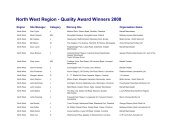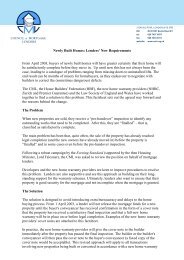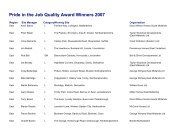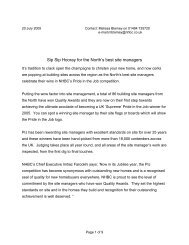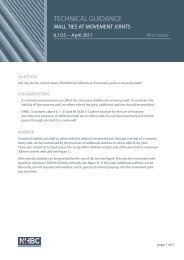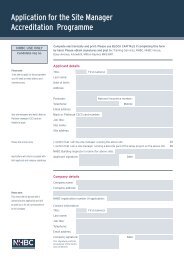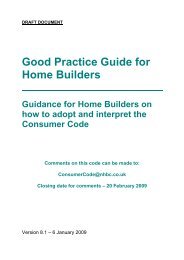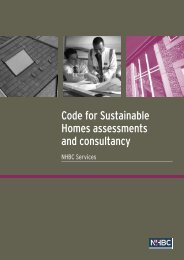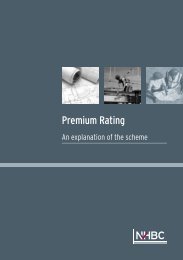Current Buildmark Connect policy - NHBC Home
Current Buildmark Connect policy - NHBC Home
Current Buildmark Connect policy - NHBC Home
- No tags were found...
Create successful ePaper yourself
Turn your PDF publications into a flip-book with our unique Google optimized e-Paper software.
page 3 DefinitionsDefinitionsThis <strong>policy</strong> is called <strong>Buildmark</strong> <strong>Connect</strong>. In this <strong>policy</strong>, for clarity, ‘you’ and ‘your’ mean the first Owner or a later Owner. ‘<strong>NHBC</strong>’,‘we’, ‘our’ and ‘us’ mean the National House-Building Council. Because this is a legal document, it is necessary to define certainwords. These are printed in bold type and defined below. Each time we use one of these words, it will have the same meaning.These definitions apply only to this <strong>policy</strong>; other policies have their own definitions.BlightBuilder<strong>Buildmark</strong> <strong>Connect</strong><strong>Buildmark</strong> <strong>Connect</strong> OfferCommon PartsComplete, CompletionContractCostDamageDefectDevelopmentExcessThe effect on the value of your Premises of the existence or former existence of contamination(whether actual or alleged).The company or person named on the <strong>Buildmark</strong> <strong>Connect</strong> Offer document that is responsible forbuilding or conversion of the Premises.The document containing the cover provided by <strong>NHBC</strong> (underwritten by the Insurer) and the Builder.The form which contains the offer of cover under <strong>Buildmark</strong> <strong>Connect</strong> made by <strong>NHBC</strong> and the Builder.Any of the following which are not for your exclusive use and for which you are legally obliged to shareresponsibility for cost and upkeep with the Owners of other Premises, houses, flats and maisonettes:a The parts of any building containing your and other Premises, flats or maisonettes.b Any garage or parking area, permanent outbuilding, retaining wall, boundary wall, external hand railor balustrade, path, drive, garden area or paved area; newly built by the Builder at the date of theInsurance Certificate.c Any drainage system serving your Premises.d Any existing garage, permanent outbuilding, retaining wall or boundary wall that forms part of theCommon Parts and is acquired by the first Owner under the original Contract.The date when <strong>NHBC</strong> agrees that the Premises substantially comply with <strong>NHBC</strong> Requirements.A legally binding agreement or, in Scotland, a missive between the first Owner and the Builder for theacquisition (either freehold or leasehold) or building of the Premises.The cost the Insurer would have had to pay if it had arranged for the work to be done.Physical damage to the Premises caused by a Defect.A breach of any mandatory <strong>NHBC</strong> Requirements by the Builder or anyone employed by the Builder oracting for the Builder. Failure to follow the guidance supporting these <strong>NHBC</strong> Requirements does not initself amount to a Defect as there may be other ways that the required performance can be achieved.An area of land which is covered by a single detailed planning consent or a series of consents relatingto continuous development by the Builder.The amount for which we have no liability. An Excess of £10,000 will apply to each and every incidentof Damage. This figure was set on 1 March 2008 and will be increased on 1 April each year in line withthe Royal Institution of Chartered Surveyors House Rebuilding Cost Index. The figure which applies to aclaim is the one which was in force when the claim was first notified to <strong>NHBC</strong>.
Definitions page 4Insurance CertificateInsurerMaximum Insured Value<strong>NHBC</strong> RequirementsOwnerPremisesStatutory NoticeYour LandThe certificate <strong>NHBC</strong> issue on Completion.Aviva Insurance Limited, registered office, Perth PH2 0NH, company number SC002116.Authorised and regulated by the Financial Services Authority.The net development cost notified to <strong>NHBC</strong> by the Builder when it registered the Premises.The mandatory requirements <strong>NHBC</strong> publish in the <strong>NHBC</strong> Standards which are in force when theconcreting of the foundations of a newly built Premises or, if applicable, the Common Parts has begun,or when conversion work affecting the Premises or Common Parts is started.The first Owner named on the <strong>Buildmark</strong> <strong>Connect</strong> Offer and any later Owner. You must be (or havecontracted to be) the freehold owner of the Premises, or have a lease of the Premises, which specifiesthat you are legally responsible for the work insured by this <strong>policy</strong>. Owner includes a mortgagee orheritable creditor in possession of the Premises.The commercial or industrial premises referred to in the <strong>Buildmark</strong> <strong>Connect</strong> Offer, together with any ofthe following, which are included in the original Contract:a Any Common Parts.b Any garage, permanent outbuilding, retaining wall, boundary wall, external handrail or balustrade,path, drive, garden area or paved area newly built by the Builder at the date of the Insurance Certificate.c The drainage system serving your Premises for which you are responsible.d Any existing garage, permanent outbuilding, retaining wall or boundary wall acquired by the firstOwner under the original Contract.Premises does not include any fence, temporary structure, fitting out works and related materials,shop front, swimming pool, lift, or any electrical fixed wiring and lighting system, heating system, airconditioning, smoke alarms, waste disposal units or water softening equipment, electronic ormechanical equipment (whether built in or not). It does not include any road or any associatedfootpath or footway.A notice served on you by a statutory authority under legislation which requires you to carry outremediation of contamination.The ground which surrounds and supports your Premises and which was:a sold or let together with the Premises to the first Owner at the same time as the Contract wasentered into or concluded; orb owned or leased by the first Owner when a Contract for building the Premises was entered into,together with land which you are legally bound to maintain or contribute towards maintainingunder the terms of the original Contract.
page 9 Section ASection A - The first 2 years after completionThe Builder’s obligationsThis part of the cover tells you what the Builder must do if it is given notice of Defects or Damage in your Premises.This notice must be given as soon as possible within the period of cover.You should keep copies of any correspondence with the Builder and any other information, such as notes of telephoneconversations, as you may need these later to prove that problems were reported in the first 2 years.The Builder must take the actions shown in the orange panel below, but does not have to take action to deal with any ofthe items in the blue panel.Period of coverThis lasts for 2 years from the date of the Insurance Certificate.There are special provisions for Common Parts, which are on page 15.What the Builder is liable forWithin a reasonable time and at the Builder’s own expense,to put right any Defect or Damage to your Premises or itsCommon Parts which is notified to the Builder within thisperiod of the cover.If the Builder is given notice of Defects or Damage withinthis period of cover, the Builder remains liable as above,even after this period of cover ends.What the Builder is not liable forWear and tear.Deterioration caused by neglect or failure to carry outnormal or specific maintenance.Dampness, condensation or shrinkage not caused bya Defect.Anything excluded by <strong>NHBC</strong> on the Insurance Certificate.Anything caused by, or resulting from, any work done on,in, or affecting your Premises after the date of theInsurance Certificate.Any Defect or Damage resulting from compliance withwritten instructions given by or on behalf of the firstOwner in respect of design, materials or workmanship.Any Cost or expense greater than that necessary to carryout a workmanlike repair of the Defect or Damage.Any items falling outside the definition of Premises.If you are not the first Owner, anything which you knewabout when you acquired the Premises and which resultedin a reduction in the purchase price you paid or which wastaken into account in any other arrangement.
Section A page 10The <strong>Buildmark</strong> <strong>Connect</strong> insuranceThis part of the cover only applies if the Builder does not meet its obligations under Section A.The Insurer will either pay for the items in the orange panel below or, at its option, arrange for the necessary work to be carriedout at its expense. The Insurer will not pay for the items in the blue panel.Period of coverThis lasts for 2 years from the date of the Insurance Certificate.There are special provisions for Common Parts, which are on page 15.Financial limitsThe most the Insurer will pay for all claims relating to your Premises under Sections A and B together is the Maximum InsuredValue as shown on the Insurance Certificate up to a maximum of:• £1 million for a newly built Premises, provided that <strong>NHBC</strong>’s and the Insurer’s total aggregate liability underall <strong>NHBC</strong> policies issued in respect of a continuous newly built structure will not exceed £25 million.• £500,000 for a converted Premises, provided that <strong>NHBC</strong>’s and the Insurer’s total aggregate liability underall <strong>NHBC</strong> policies issued in respect of a continuous converted structure will not exceed £5 million.The financial limit will be increased each year in line with the Royal Institution of Chartered Surveyors’ House Re-building CostIndex or, if less, by 10% compound per year. If the Insurer accepts a claim, the cost of the claim will be deducted from thefinancial limit. The balance will then continue to be increased as above.What the Insurer will pay forIf the Builder does not pay you the whole or any part of anyamount that it is obliged to pay you under an arbitrationaward or court judgment in respect of the Builder’s failureto fulfil its obligations under Section A, and you have takenall reasonable steps to enforce the award or court judgment,then the Insurer will pay you the unpaid amount, less anyamount that you are obliged to pay the Builder under or inconnection with the same arbitration or court proceedings.What the Insurer will not pay forAnything for which you have held back a sum of money.If you have done so, the Insurer will be entitled to deductthis amount from the sum that it would otherwise pay.If the Insurer arranges for the work to be carried out, youmust pay the Insurer this amount before the work starts.Contaminated landIf the Builder is insolvent, and action is taken against you because of contamination that existed at the date of Completion,the Insurer will assist you in accordance with the terms of the cover on page 13 of this document.
page 11 Section BSection B - Cover in years 3 to 10Under this part of the cover, you must tell <strong>NHBC</strong> of your claim as soon as possible within this period of cover.The Insurer will either pay for the items in the orange panel on the next page or, at its option, arrange for the necessary work tobe carried out at its expense. The Insurer will not pay for the items in the blue panel.There are special provisions for Common Parts, which are on page 15.Period of coverThis starts 2 years after the date shown on the Insurance Certificate and ends 10 years after the date shown on theInsurance Certificate.Financial limitsThe most the Insurer will pay for all claims relating to your Premises under Sections A and B together is the Maximum InsuredValue as shown on the Insurance Certificate up to a maximum of:• £1 million for a newly built Premises, provided that <strong>NHBC</strong>’s and the Insurer’s total aggregate liability underall <strong>NHBC</strong> policies issued in respect of a continuous newly built structure will not exceed £25 million.• £500,000 for a converted Premises, provided that <strong>NHBC</strong>’s and the Insurer’s total aggregate liability underall <strong>NHBC</strong> policies issued in respect of a continuous converted structure will not exceed £5 million.The financial limit will be increased each year in line with the Royal Institution of Chartered Surveyors’ House Re-building CostIndex or, if less, by 10% compound per year. If the Insurer accepts a claim, the cost of the claim will be deducted from thefinancial limit. The balance will then continue to be increased as above.How to make a claim - what you must doContact <strong>NHBC</strong> (see page 7) as soon as the Damage has been noticed.Give <strong>NHBC</strong> the opportunity to inspect before any work is done.If we ask for them, send <strong>NHBC</strong> copies of any correspondence, contracts, plans, quotations, receipts and any other documents orinformation relating to your Premises.
Section B page 12What the Insurer will pay forThe Cost above the Excess of putting right any actualphysical Damage caused by a Defect in the following partsof the Premises or its Common Parts:• Foundations.• Load-bearing walls.• Load-bearing parts of the roof.• Wet applied plaster.• External render and external vertical tile hanging.• Roof coverings.• Load-bearing parts of the floors.• Floor decking, screeds and staircases, where these failto support normal loads.• Retaining walls necessary for the structural stabilityof the Premises, and any garage or other permanentoutbuilding forming part of, and constructed at thesame time as, the Premises.• Below-ground drainage for which you are responsible.What the Insurer will not pay forAny claim where the Cost of repair is less than the Excess.Anything which was, or which could have been, reported tothe Builder under Section A. For these claims please seeSection A, page 9 of the <strong>policy</strong>.Claims relating to:• Shrinkage, thermal movement or movement betweendifferent types of materials.• Cosmetic damage, such as minor cracking, spalling ormortar erosion to brickwork, which does not impair thestructural stability or weather tightness of the Premisesor which only affects decorations.• Existing double or triple-glazing panes in convertedproperties, unless they were newly-installed at the timeof conversion.• Ceilings which are not in an enclosed part of thePremises e.g. balcony ceilings.• Water entry, dampness or condensation to undergroundgarages, where the structural integrity of the garage isnot affected.• Sound transmission of any type.• any change to the colour or texture of, or any stainingto, any external finish.• Replacement of any solar roof tiles or panels solelydue to failure to generate heat or electricity.• Removal, storage and alternative premises if you oranyone normally occupying the Premises moves outso that work can be done.Anything listed in the General exclusions for claims,earlier in this booklet.
page 13 Section CSection C - Cover in years 3 to 10 for contaminated landThis part of the cover tells you what we will do if action is taken against you because of contamination that existed at the dateof Completion.Financial limitsThe most the Insurer will pay for any claims relating to the Premises under section C is the Maximum Insured Value up to amaximum of:• £1 million for a newly built Premises; or• £500,000 for a converted Premises;provided that <strong>NHBC</strong>’s and the Insurer’s total aggregate liability under all <strong>NHBC</strong> policies issued in respect of any one Developmentwill not exceed £20 million.The financial limit will be increased each year in line with the Royal Institution of Chartered Surveyors’ House Re-building CostIndex or, if less, by 10% compound per year. If the Insurer accepts a claim, the cost of the claim will be deducted from thefinancial limit. The balance will then continue to be increased as above.If there are one or more substances in, on or under Your Land which results, or could reasonably be expected to result, in theservice on you of a Statutory Notice, then the Insurer will, solely at its option, do one of the things shown in the orange panel.The Insurer will not do the things shown in the blue panel (see below).You must notify <strong>NHBC</strong> in writing as soon as you become aware that contamination in, on or under Your Land is suspected orhas been found (for example, if a local authority or Government department issues you with a Notification of the Identificationof Contaminated Land). If you do not tell us promptly, liability shown in the orange panel on the next page will be limited to thosecosts and expenses that the Insurer would have incurred had we been told promptly.What the Insurer will doAt its option:pay the Cost of treating or isolatingor removing those substances fromYour Land in a controlled manner inaccordance with the requirementsof the Statutory Notice;ORarrange for the work referred toabove to be carried out at itsown expense.What the Insurer will not doMeet any other liability under this Section for any other losses, damages,or expenses of any type, whatever their cause.Meet any costs, losses, expenses or damages for:• Death, bodily injury, disease, illness or injury to mental health.• Blight.• Breach of any covenant which the first Owner entered into (for example,not to do anything which would adversely affect or interfere with aprecautionary measure, such as a membrane, installed by the Builder).• Contamination which first occurs after Completion.• Contamination that migrates on to Your Land.• Contamination that migrates from Your Land.• Contamination that could not have resulted in the issue of a Statutory Noticeunder legislation and/or Government guidance in force at the date of Completion.• Any criminal penalties arising out of or connected with contamination in,on or under Your Land.• Removal, storage and alternative premises if you or anyone normallyoccupying the Premises moves out so that work can be done.Anything listed in the General exclusions for claims, earlier in this booklet.
General conditions/War and terrorism exclusions/Govering law page 14How to make a claim - what you must doContact <strong>NHBC</strong> (see page 7) as soon as you think you need to make a claim.Give <strong>NHBC</strong> the opportunity to inspect your Premises before any work is done.If we ask for them, send <strong>NHBC</strong> copies of any Statutory Notice, correspondence, contracts, plans, quotations, receipts and anyother documents or information relating to your Premises.General conditions1 If the Insurer accepts any claim for which you could recover compensation from some other person, you must, at the Insurer’sexpense, do whatever it may reasonably require to:a recover compensation from that person for the Insurer’s; orb enable the Insurer to enforce any rights you may have to that compensation by taking over your claim against that otherperson or in any other way.2 You must take all reasonable steps to reduce damage. The Insurer will not pay for any work or other costs which result solelyfrom your failure to do this.Important noteIt is illegal to make a fraudulent claim.War and terrorism exclusionsNeither <strong>NHBC</strong>, the Insurer nor the Builder is liable for loss, damage, costs or expense directly or indirectly caused by,resulting from, or in connection with:1 war, invasion, acts of foreign enemies, hostilities (whether war is declared or not), civil war, rebellion, revolution, insurrection,use of military or usurped power or confiscation, nationalisation, requisition or destruction of or damage to property by orunder the order of any government or public or local authority; or2 an act of terrorism* – regardless of the timing of another contributing cause or event; or action taken to control, prevent orsuppress an act of terrorism*; or action in any way relating to an act of terrorism*.If you claim and we decide that this exclusion means the insurance does not cover a particular instance of loss or damage orsome particular costs or expenses, then it would be for you to prove the contrary.*In this exclusion, an ‘act of terrorism’ means an act – including force, violence or threat by a person or group whether actingalone or on behalf of, or in connection with, an organisation or government – that is committed for political, religious, ideologicalor similar purposes including the intention to influence a government or to put people in fear.Governing lawThe law of the country in which the Premises are situated will apply to this <strong>policy</strong>. The courts of that country will haveexclusive jurisdiction.Use of language and customers with disabilitiesUnless otherwise agreed, the contractual terms and conditions and other information relating to this contract will be in English.This <strong>policy</strong> can be made available in large print, audio and Braille. If you require any of these formats please contact CustomerServices, <strong>NHBC</strong>, <strong>NHBC</strong> House, Davy Avenue, Milton Keynes, Bucks MK5 8FP. Telephone 0844 633 1000 or email: css@nhbc.co.uk
page 15 The Financial Services Compensation Scheme (FSCS)/Common PartsThe Financial Services Compensation Scheme (FSCS)Aviva Insurance Limited is a member of the FSCS. As an Owner you may be entitled to compensation from the FSCS in theunlikely event that the Insurer is unable to meet its obligations.Further information about compensation scheme arrangements is available from FSCS. Their address is:Financial Services Compensation Scheme7th Floor Lloyds ChambersPortsoken StreetLondonE1 8BNCommon PartsThe following periods of cover, financial limits and conditions apply only if:a your Premises have Common Parts; andb Defects or Damage in, or affecting, the Common Parts have been notified to <strong>NHBC</strong> or the Builder.If you are in any doubt, we can inform you of the actual periods of cover.Periods of coverSection AThe cover in Section A starts on the date of the earliest Insurance Certificate for Premises, houses, flats and maisonettes whichshare the relevant Common Parts. It ends 3 years from that date, or 2 years from the date of the last Insurance Certificate forPremises, houses, flats and maisonettes which share those Common Parts, whichever is the earlier.Sections B and CThe cover in Sections B and C starts from the date cover under Section A expires. It ends 8 years from that date.Financial limits applying to a claimThe most the Insurer will pay for your share of any claim relating to Common Parts will be the proportion of the total Cost ofrepairs that the Insurer considers it is reasonable to attribute to you. The Insurer’s total liability for your share will not exceedthe financial limit of cover for your Premises in the relevant Section.For claims under Section B (see pages 4 and 5), if your share of the Cost of repairing any Defect is less than the Excess,the Insurer will not pay your share. If your share of the Cost of the repair is more than the Excess, the Insurer will pay thebalance of your share above the Excess, subject to the Maximum Insured Value.Special conditionIf requested, you must join with the Owners of other Premises, or any house, flat or maisonette sharing the relevant CommonParts, in making a claim. If you do not do so, the Insurer will still deduct the amount that you are legally liable to contributetowards the Cost of the repairs from the financial limit of cover for your Premises in the relevant Section.
Complaints and disputes procedure page 16Complaints and disputes procedureComplaints against <strong>NHBC</strong> or the InsurerAt <strong>NHBC</strong> we pride ourselves on the service we give to our customers.If you are not satisfied with the way we handle your request for assistance or your claim, please write to the GeneralManager – Claims at:<strong>NHBC</strong><strong>NHBC</strong> HouseDavy AvenueKnowlhillMilton KeynesMK5 8FPThe General Manager’s own staff will investigate or review your file and will give you a written response.If you are still not satisfied after this review, you should write to the Chief Executive of Aviva Insurance Limited at:Aviva Insurance LimitedSurrey StreetNorwichNR1 3NSAfter the Chief Executive of Aviva Insurance Limited has carried out a review, if your dispute is about the insurance cover and youare an eligible complainant, you have the right to refer the matter to the Financial Ombudsman Service at the following address:Financial Ombudsman ServiceSouth Quay Plaza183 Marsh WallLondonE14 9SRTel 0845 080 1800Email: enquiries@financial-ombudsman.org.ukThe Financial Services Authority definition of an eligible complainant is:• A private individual.• A business which has a group turnover of less than £1 million.• A charity with an annual income of less than £1 million.• A trustee of a trust with a net asset value of less than £1 million.For other Owners, the other options for resolving disputes are set out on the next page.The Financial Ombudsman Service cannot consider any dispute relating to the Builder’s obligations under <strong>Buildmark</strong> <strong>Connect</strong> andif your dispute is with the Builder then this will also need to be referred to another form of dispute resolution process as set outon the next page.Following the complaints procedure does not affect your legal rights.
page 17 Complaints and disputes procedureThe Association of British InsurersThis is an association for insurance companies, which produces codes of practice for the industry. It acts as a spokesperson onmany issues. Unlike the Financial Ombudsman Service, it has no dispute resolution role but you may find that it can give adviceon general insurance matters. Its address is:The Association of British Insurers51 Gresham StreetLondonEC2V 7HQTel: 0207 600 3333Other options for resolving disputes with <strong>NHBC</strong>, the Insurer or the BuilderThe following notes show some alternatives for resolving different types of disputes. You may wish to seek advice about the mostsuitable method to meet your specific needs.Alternative dispute resolution (ADR)There are many forms of ADR available to assist in resolving different types of disputes. These schemes are often informal andmay be used without legal representation.ArbitrationArbitration has the advantage of being generally quicker than court actions and can deal with any matters, provided both partiesagree. In Scotland, arbitrators are called arbiters. An arbitrator’s award is legally binding and can be enforced in the same way asa court judgment. However, as in court proceedings, one party may have to pay the costs and arbitrator’s fees. Further details areavailable free of charge from IDRS Limited, a wholly-owned subsidiary of the Chartered Institute of Arbitrators. IDRS Limited willappoint an arbitrator upon your application. Their address is:IDRS Limited24 Angel GateCity RoadLondonEC1V 2PTTel: 0207 520 3800Small Claims CourtThe Small Claims Court may be suitable in resolving relatively small disputes where the amount falls below a specified level.It has the advantage of being quicker than other forms of court action and the proceedings are less formal. Details are availablefrom any County Court office or, in Scotland, the Sheriff Clerk’s office.Other courtsThe courts may be suitable for resolving different types of claims involving contractual, financial and boundary disputes, as wellas disputes about standards of workmanship, where there is significant cost and complexity.Following the complaints procedure does not affect your legal rights.
NotesNotes page 18
<strong>NHBC</strong> is authorised and regulatedby the Financial Services Authority.This leaflet has been printed onmaterial which is produced fromwell-managed forests and is fullyrecyclable and biodegradable,ECF (elemental chlorine free)and is made to ISO 14001Environmental Certification.<strong>NHBC</strong>, <strong>NHBC</strong> House,Davy Avenue, Knowlhill,Milton Keynes,Bucks MK5 8FPTel: 0844 633 1000Fax: 0844 633 0022www.nhbc.co.ukHB2392 03/10




